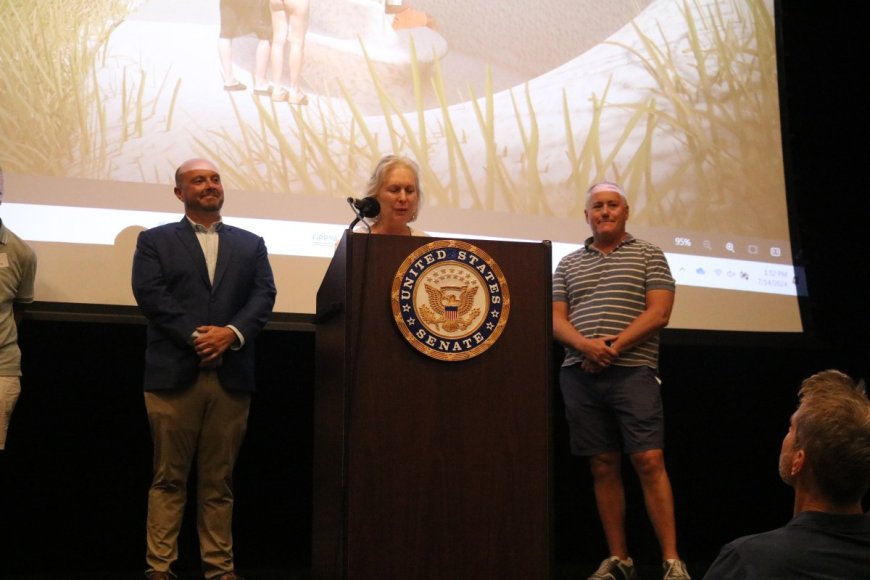U.S. Senator Kirsten Gillibrand Holds Fire Island AIDS Memorial Press Conference in the Pines
U.S. Senator Kirsten Gillibrand (D-NY) held a press conference on July 15, 2024 to officially announce the bipartisan, bicameral Fire Island AIDS Memorial Act to the Pines and Cherry Grove communities. Senator Gillibrand was joined by Congressman Andrew Garbarino (R-NY, 2nd Dist.), who teamed up with her for this bill. Other key figures included… Read More

U.S. Senator Kirsten Gillibrand (D-NY) held a press conference on July 15, 2024 to officially announce the bipartisan, bicameral Fire Island AIDS Memorial Act to the Pines and Cherry Grove communities. Senator Gillibrand was joined by Congressman Andrew Garbarino (R-NY, 2nd Dist.), who teamed up with her for this bill. Other key figures included Jay Pagano, the former President of the Fire Island Pines Property Owner’s Association, Eric Sawyer, a New York City AIDS Memorial Board Member, and Charles Renfro, the memorial architect.
The Fire Island AIDS memorial has been a project in the making. “A few years back is when the residents brought it to my attention that there was no memorial for this (AIDS Epidemic),” said Pagano. Since the monument’s placement is planned for National Park Service territory, legislation is in order to make it happen. The Pines Foundation sought the help of Gillibrand, who responded quickly. She contacted the office of Garbarino, who agreed to help, and they proposed the bill to the House and Senate on December 14, 2023. In early June, the office of Senator Gillibrand directly confirmed to the Fire Island News that the bill was passed through the National Parks subcommittee meeting in May.
“Fire Island Pines and Cherry Grove have long been, and will always be, a home and safe haven for the LGBTQ+ community; this was especially true during the AIDS epidemic,” said Gillibrand. “We believe this will be a fitting tribute and help be a replacement for the love and joy missing in the absence of loved ones.” Since the AIDS/HIV epidemic began in 1981, it’s estimated that more than 135,000 New Yorkers have lost their lives to it. Jay Pagano lived through the epidemic and recalls seeing the sick and dead walking through the streets of the especially affected Pines and Cherry Grove communities. “In 1988, it was like living in a ghost town,” Pagano explained.
Eric Sawyer, who himself has been HIV positive since the 80s, painted the picture of what it was like to everyone in Whyte Hall on Sunday. He lost many of his colleagues. “At the end of every summer, I would go to the back of the ferry and just pray, saying ‘please god, please let me and my friends live through this winter,’” a very emotional Sawyer said. “You would return in the spring and go to your friends’ houses, praying they would be there. Once, I checked on my good friend, and everyone said, ‘Oh my, you didn’t hear, he passed,’ it was terrible. I don’t want all those lost to be forgotten.”
The community gathered to hear the official announcement of the memorial act was brought to tears, as did the Senator and Congressman stood on the stage.
Congressman Garbarino is no stranger to the Pines himself. He grew up in Sayville, working only a few blocks from the Sayville ferry in the local hardware store. His family spent much time on the Fire Island Pines’ beaches; his sisters even worked in the pizza shops. “We have a great community here on the South Shore, including the Pines and Cherry Grove; I’m very grateful and happy to lead it through the house,” Garbarino said. One of the main striking points of the memorial is to educate future generations about what happened to these communities. “It’s important to educate the future, and I am going to get this through the Republican House,” an adamant Garbarino stated.
The National Park Service (NPS) has stated that the memorial will be located “along the walkway between the Fire Island Pines and Cherry Grove and adjacent to the Carrington house.” Charles Renfro, the architect who created the preliminary design, discussed why it would be placed there. “During the epidemic, people would scatter the ashes of their lost loved ones into the Atlantic Ocean, turning the beach into a burial ground,” Renfro explained. “The memorial will overlook the ocean in the shape of a wave, it can hold up to eight visitors at a time, and the sound of the ocean will reflect into the memorial, allowing you to become one with the ocean and your lost loved ones.”
The costs of the memorial will be covered by donations to the Fire Island Pines Foundation, as will maintenance costs. “No community should have to experience this again; we want it to serve as a reminder to fight against bigotry and discrimination, and we can’t wait for it to come to fruition soon,” Gillibrand said. “I am so proud to be standing with this community today.”

 Mark
Mark 





